Quality Management Strategies for QTC's Excellence
VerifiedAdded on 2023/01/12
|13
|3737
|26
Report
AI Summary
This report focuses on quality management strategies for Quality Tooling Company (QTC), a manufacturer of engineering and medical equipment. It explores quality improvement strategies, including building a quality culture, improving supplier relations, integrating technology, and focusing on customer needs. The report delves into Total Quality Management (TQM), emphasizing customer focus, leadership, people engagement, process improvement, evidence-based decision-making, and relationship management. It also examines quality assurance methods, such as failure testing, statistical process control (SPC), and the PDCA method, and quality control methods, including inspection, statistical quality control, checklists, and various diagrams. The report highlights the contribution of these strategies in sustaining a quality culture within QTC and ensuring its long-term success in a competitive environment.
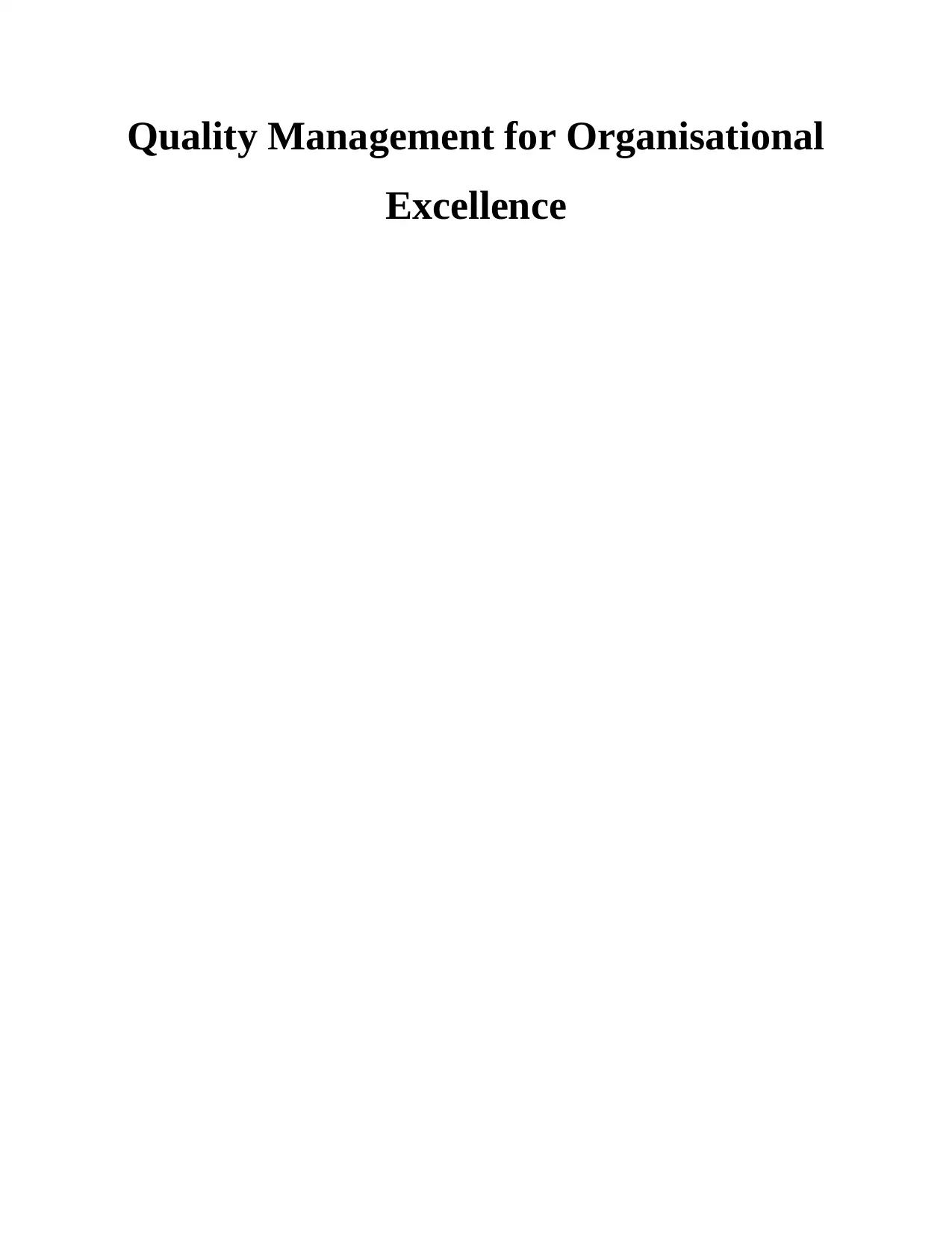
Quality Management for Organisational
Excellence
Excellence
Paraphrase This Document
Need a fresh take? Get an instant paraphrase of this document with our AI Paraphraser
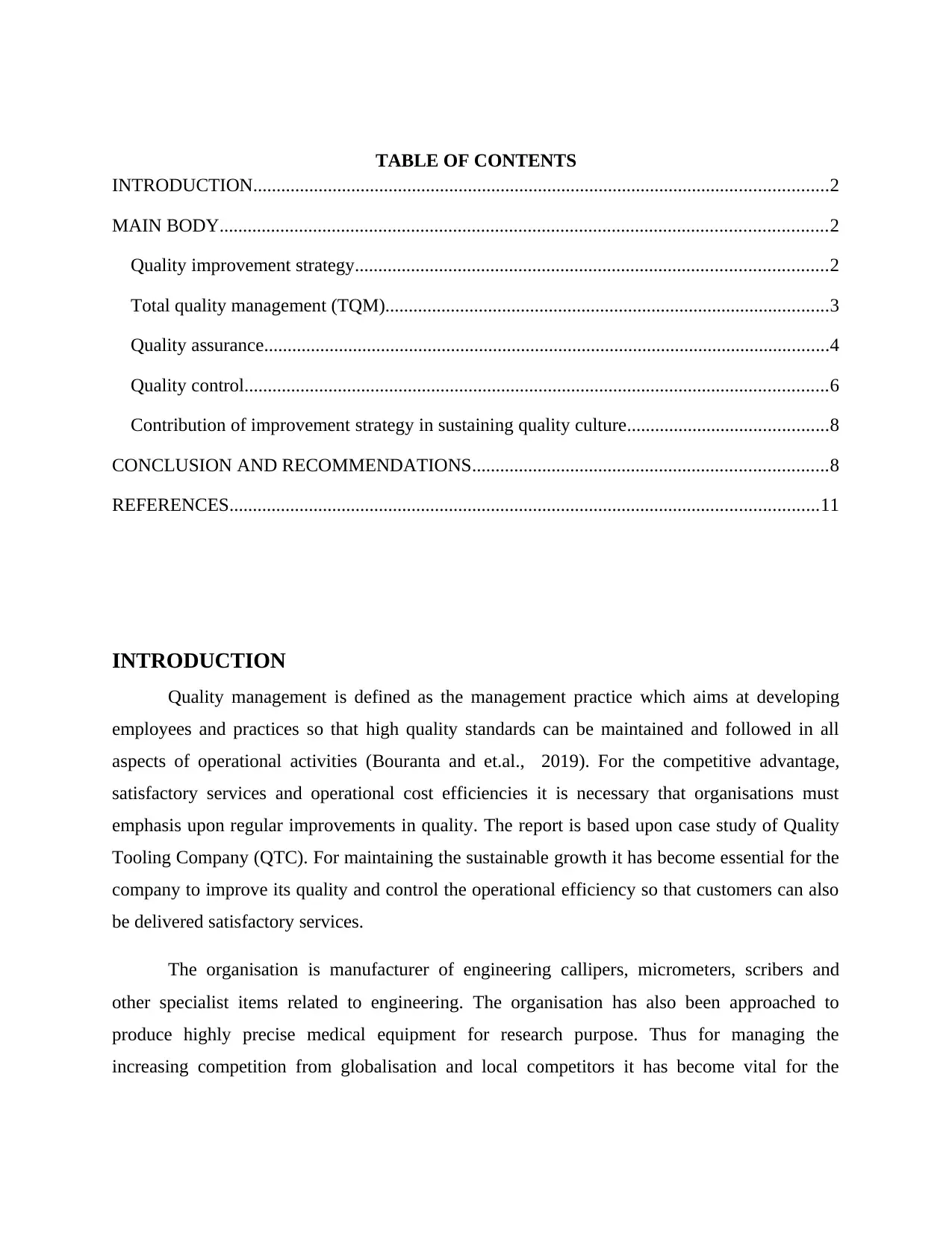
TABLE OF CONTENTS
INTRODUCTION...........................................................................................................................2
MAIN BODY..................................................................................................................................2
Quality improvement strategy.....................................................................................................2
Total quality management (TQM)...............................................................................................3
Quality assurance.........................................................................................................................4
Quality control.............................................................................................................................6
Contribution of improvement strategy in sustaining quality culture...........................................8
CONCLUSION AND RECOMMENDATIONS............................................................................8
REFERENCES..............................................................................................................................11
INTRODUCTION
Quality management is defined as the management practice which aims at developing
employees and practices so that high quality standards can be maintained and followed in all
aspects of operational activities (Bouranta and et.al., 2019). For the competitive advantage,
satisfactory services and operational cost efficiencies it is necessary that organisations must
emphasis upon regular improvements in quality. The report is based upon case study of Quality
Tooling Company (QTC). For maintaining the sustainable growth it has become essential for the
company to improve its quality and control the operational efficiency so that customers can also
be delivered satisfactory services.
The organisation is manufacturer of engineering callipers, micrometers, scribers and
other specialist items related to engineering. The organisation has also been approached to
produce highly precise medical equipment for research purpose. Thus for managing the
increasing competition from globalisation and local competitors it has become vital for the
INTRODUCTION...........................................................................................................................2
MAIN BODY..................................................................................................................................2
Quality improvement strategy.....................................................................................................2
Total quality management (TQM)...............................................................................................3
Quality assurance.........................................................................................................................4
Quality control.............................................................................................................................6
Contribution of improvement strategy in sustaining quality culture...........................................8
CONCLUSION AND RECOMMENDATIONS............................................................................8
REFERENCES..............................................................................................................................11
INTRODUCTION
Quality management is defined as the management practice which aims at developing
employees and practices so that high quality standards can be maintained and followed in all
aspects of operational activities (Bouranta and et.al., 2019). For the competitive advantage,
satisfactory services and operational cost efficiencies it is necessary that organisations must
emphasis upon regular improvements in quality. The report is based upon case study of Quality
Tooling Company (QTC). For maintaining the sustainable growth it has become essential for the
company to improve its quality and control the operational efficiency so that customers can also
be delivered satisfactory services.
The organisation is manufacturer of engineering callipers, micrometers, scribers and
other specialist items related to engineering. The organisation has also been approached to
produce highly precise medical equipment for research purpose. Thus for managing the
increasing competition from globalisation and local competitors it has become vital for the
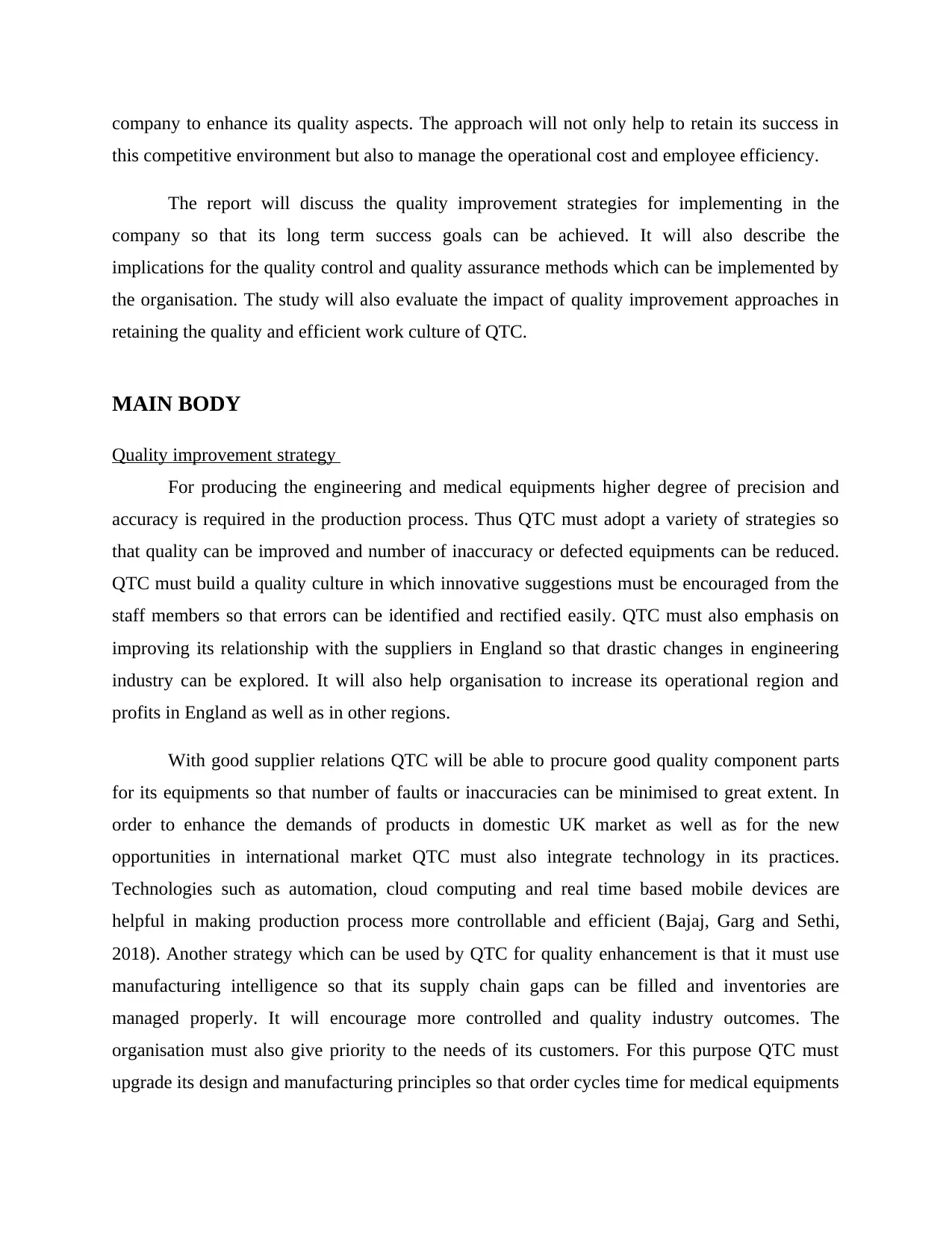
company to enhance its quality aspects. The approach will not only help to retain its success in
this competitive environment but also to manage the operational cost and employee efficiency.
The report will discuss the quality improvement strategies for implementing in the
company so that its long term success goals can be achieved. It will also describe the
implications for the quality control and quality assurance methods which can be implemented by
the organisation. The study will also evaluate the impact of quality improvement approaches in
retaining the quality and efficient work culture of QTC.
MAIN BODY
Quality improvement strategy
For producing the engineering and medical equipments higher degree of precision and
accuracy is required in the production process. Thus QTC must adopt a variety of strategies so
that quality can be improved and number of inaccuracy or defected equipments can be reduced.
QTC must build a quality culture in which innovative suggestions must be encouraged from the
staff members so that errors can be identified and rectified easily. QTC must also emphasis on
improving its relationship with the suppliers in England so that drastic changes in engineering
industry can be explored. It will also help organisation to increase its operational region and
profits in England as well as in other regions.
With good supplier relations QTC will be able to procure good quality component parts
for its equipments so that number of faults or inaccuracies can be minimised to great extent. In
order to enhance the demands of products in domestic UK market as well as for the new
opportunities in international market QTC must also integrate technology in its practices.
Technologies such as automation, cloud computing and real time based mobile devices are
helpful in making production process more controllable and efficient (Bajaj, Garg and Sethi,
2018). Another strategy which can be used by QTC for quality enhancement is that it must use
manufacturing intelligence so that its supply chain gaps can be filled and inventories are
managed properly. It will encourage more controlled and quality industry outcomes. The
organisation must also give priority to the needs of its customers. For this purpose QTC must
upgrade its design and manufacturing principles so that order cycles time for medical equipments
this competitive environment but also to manage the operational cost and employee efficiency.
The report will discuss the quality improvement strategies for implementing in the
company so that its long term success goals can be achieved. It will also describe the
implications for the quality control and quality assurance methods which can be implemented by
the organisation. The study will also evaluate the impact of quality improvement approaches in
retaining the quality and efficient work culture of QTC.
MAIN BODY
Quality improvement strategy
For producing the engineering and medical equipments higher degree of precision and
accuracy is required in the production process. Thus QTC must adopt a variety of strategies so
that quality can be improved and number of inaccuracy or defected equipments can be reduced.
QTC must build a quality culture in which innovative suggestions must be encouraged from the
staff members so that errors can be identified and rectified easily. QTC must also emphasis on
improving its relationship with the suppliers in England so that drastic changes in engineering
industry can be explored. It will also help organisation to increase its operational region and
profits in England as well as in other regions.
With good supplier relations QTC will be able to procure good quality component parts
for its equipments so that number of faults or inaccuracies can be minimised to great extent. In
order to enhance the demands of products in domestic UK market as well as for the new
opportunities in international market QTC must also integrate technology in its practices.
Technologies such as automation, cloud computing and real time based mobile devices are
helpful in making production process more controllable and efficient (Bajaj, Garg and Sethi,
2018). Another strategy which can be used by QTC for quality enhancement is that it must use
manufacturing intelligence so that its supply chain gaps can be filled and inventories are
managed properly. It will encourage more controlled and quality industry outcomes. The
organisation must also give priority to the needs of its customers. For this purpose QTC must
upgrade its design and manufacturing principles so that order cycles time for medical equipments
⊘ This is a preview!⊘
Do you want full access?
Subscribe today to unlock all pages.

Trusted by 1+ million students worldwide
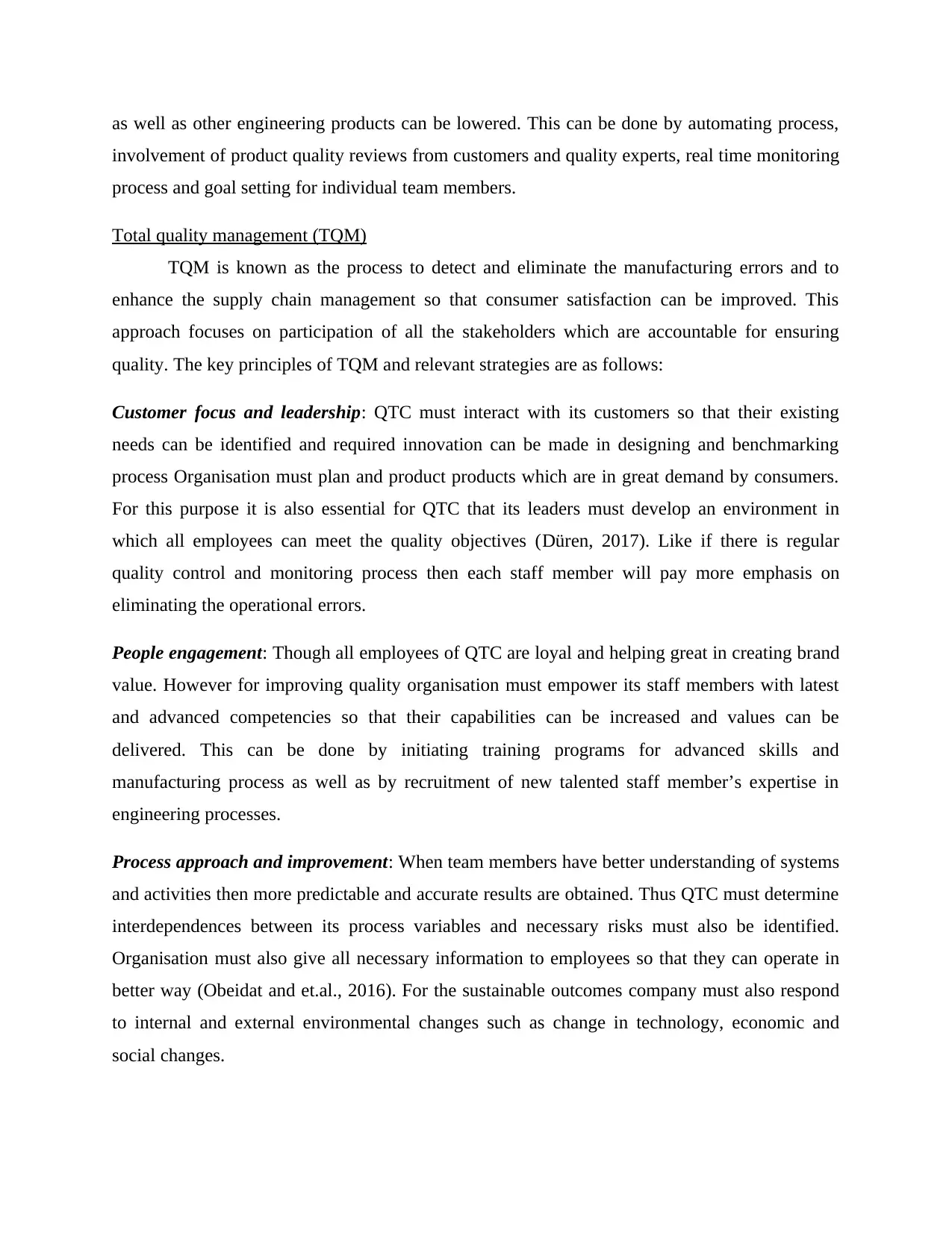
as well as other engineering products can be lowered. This can be done by automating process,
involvement of product quality reviews from customers and quality experts, real time monitoring
process and goal setting for individual team members.
Total quality management (TQM)
TQM is known as the process to detect and eliminate the manufacturing errors and to
enhance the supply chain management so that consumer satisfaction can be improved. This
approach focuses on participation of all the stakeholders which are accountable for ensuring
quality. The key principles of TQM and relevant strategies are as follows:
Customer focus and leadership: QTC must interact with its customers so that their existing
needs can be identified and required innovation can be made in designing and benchmarking
process Organisation must plan and product products which are in great demand by consumers.
For this purpose it is also essential for QTC that its leaders must develop an environment in
which all employees can meet the quality objectives (Düren, 2017). Like if there is regular
quality control and monitoring process then each staff member will pay more emphasis on
eliminating the operational errors.
People engagement: Though all employees of QTC are loyal and helping great in creating brand
value. However for improving quality organisation must empower its staff members with latest
and advanced competencies so that their capabilities can be increased and values can be
delivered. This can be done by initiating training programs for advanced skills and
manufacturing process as well as by recruitment of new talented staff member’s expertise in
engineering processes.
Process approach and improvement: When team members have better understanding of systems
and activities then more predictable and accurate results are obtained. Thus QTC must determine
interdependences between its process variables and necessary risks must also be identified.
Organisation must also give all necessary information to employees so that they can operate in
better way (Obeidat and et.al., 2016). For the sustainable outcomes company must also respond
to internal and external environmental changes such as change in technology, economic and
social changes.
involvement of product quality reviews from customers and quality experts, real time monitoring
process and goal setting for individual team members.
Total quality management (TQM)
TQM is known as the process to detect and eliminate the manufacturing errors and to
enhance the supply chain management so that consumer satisfaction can be improved. This
approach focuses on participation of all the stakeholders which are accountable for ensuring
quality. The key principles of TQM and relevant strategies are as follows:
Customer focus and leadership: QTC must interact with its customers so that their existing
needs can be identified and required innovation can be made in designing and benchmarking
process Organisation must plan and product products which are in great demand by consumers.
For this purpose it is also essential for QTC that its leaders must develop an environment in
which all employees can meet the quality objectives (Düren, 2017). Like if there is regular
quality control and monitoring process then each staff member will pay more emphasis on
eliminating the operational errors.
People engagement: Though all employees of QTC are loyal and helping great in creating brand
value. However for improving quality organisation must empower its staff members with latest
and advanced competencies so that their capabilities can be increased and values can be
delivered. This can be done by initiating training programs for advanced skills and
manufacturing process as well as by recruitment of new talented staff member’s expertise in
engineering processes.
Process approach and improvement: When team members have better understanding of systems
and activities then more predictable and accurate results are obtained. Thus QTC must determine
interdependences between its process variables and necessary risks must also be identified.
Organisation must also give all necessary information to employees so that they can operate in
better way (Obeidat and et.al., 2016). For the sustainable outcomes company must also respond
to internal and external environmental changes such as change in technology, economic and
social changes.
Paraphrase This Document
Need a fresh take? Get an instant paraphrase of this document with our AI Paraphraser
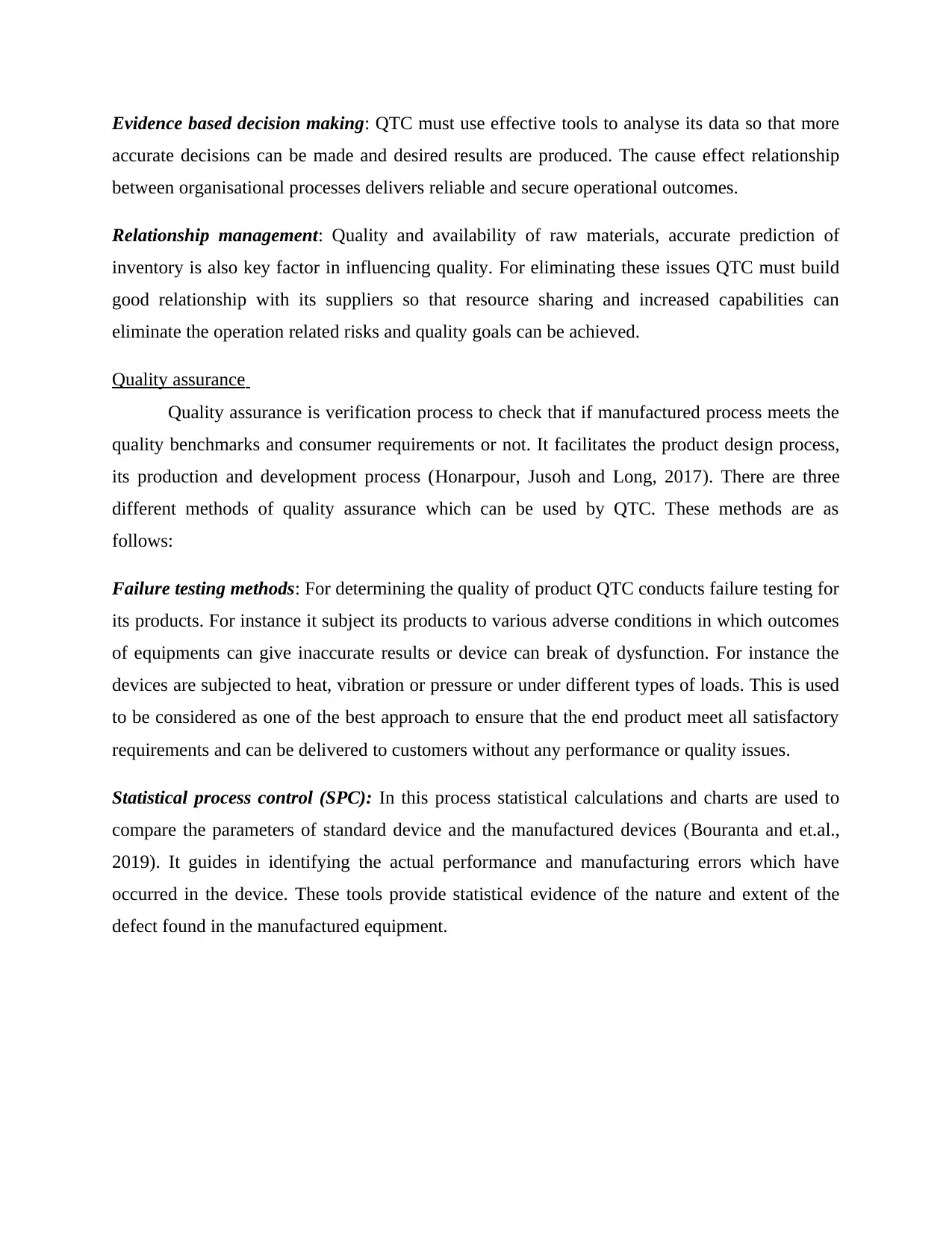
Evidence based decision making: QTC must use effective tools to analyse its data so that more
accurate decisions can be made and desired results are produced. The cause effect relationship
between organisational processes delivers reliable and secure operational outcomes.
Relationship management: Quality and availability of raw materials, accurate prediction of
inventory is also key factor in influencing quality. For eliminating these issues QTC must build
good relationship with its suppliers so that resource sharing and increased capabilities can
eliminate the operation related risks and quality goals can be achieved.
Quality assurance
Quality assurance is verification process to check that if manufactured process meets the
quality benchmarks and consumer requirements or not. It facilitates the product design process,
its production and development process (Honarpour, Jusoh and Long, 2017). There are three
different methods of quality assurance which can be used by QTC. These methods are as
follows:
Failure testing methods: For determining the quality of product QTC conducts failure testing for
its products. For instance it subject its products to various adverse conditions in which outcomes
of equipments can give inaccurate results or device can break of dysfunction. For instance the
devices are subjected to heat, vibration or pressure or under different types of loads. This is used
to be considered as one of the best approach to ensure that the end product meet all satisfactory
requirements and can be delivered to customers without any performance or quality issues.
Statistical process control (SPC): In this process statistical calculations and charts are used to
compare the parameters of standard device and the manufactured devices (Bouranta and et.al.,
2019). It guides in identifying the actual performance and manufacturing errors which have
occurred in the device. These tools provide statistical evidence of the nature and extent of the
defect found in the manufactured equipment.
accurate decisions can be made and desired results are produced. The cause effect relationship
between organisational processes delivers reliable and secure operational outcomes.
Relationship management: Quality and availability of raw materials, accurate prediction of
inventory is also key factor in influencing quality. For eliminating these issues QTC must build
good relationship with its suppliers so that resource sharing and increased capabilities can
eliminate the operation related risks and quality goals can be achieved.
Quality assurance
Quality assurance is verification process to check that if manufactured process meets the
quality benchmarks and consumer requirements or not. It facilitates the product design process,
its production and development process (Honarpour, Jusoh and Long, 2017). There are three
different methods of quality assurance which can be used by QTC. These methods are as
follows:
Failure testing methods: For determining the quality of product QTC conducts failure testing for
its products. For instance it subject its products to various adverse conditions in which outcomes
of equipments can give inaccurate results or device can break of dysfunction. For instance the
devices are subjected to heat, vibration or pressure or under different types of loads. This is used
to be considered as one of the best approach to ensure that the end product meet all satisfactory
requirements and can be delivered to customers without any performance or quality issues.
Statistical process control (SPC): In this process statistical calculations and charts are used to
compare the parameters of standard device and the manufactured devices (Bouranta and et.al.,
2019). It guides in identifying the actual performance and manufacturing errors which have
occurred in the device. These tools provide statistical evidence of the nature and extent of the
defect found in the manufactured equipment.
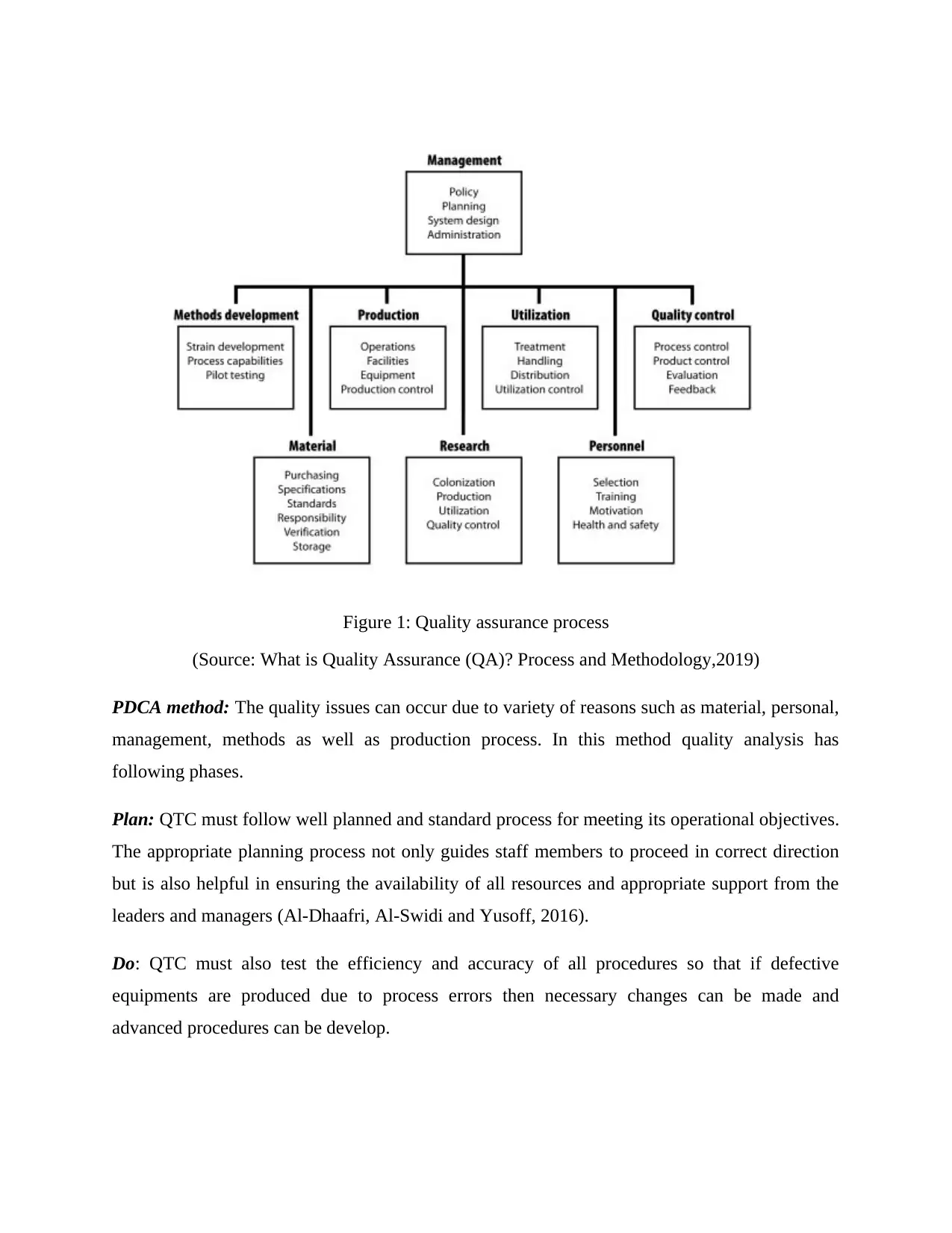
Figure 1: Quality assurance process
(Source: What is Quality Assurance (QA)? Process and Methodology,2019)
PDCA method: The quality issues can occur due to variety of reasons such as material, personal,
management, methods as well as production process. In this method quality analysis has
following phases.
Plan: QTC must follow well planned and standard process for meeting its operational objectives.
The appropriate planning process not only guides staff members to proceed in correct direction
but is also helpful in ensuring the availability of all resources and appropriate support from the
leaders and managers (Al-Dhaafri, Al-Swidi and Yusoff, 2016).
Do: QTC must also test the efficiency and accuracy of all procedures so that if defective
equipments are produced due to process errors then necessary changes can be made and
advanced procedures can be develop.
(Source: What is Quality Assurance (QA)? Process and Methodology,2019)
PDCA method: The quality issues can occur due to variety of reasons such as material, personal,
management, methods as well as production process. In this method quality analysis has
following phases.
Plan: QTC must follow well planned and standard process for meeting its operational objectives.
The appropriate planning process not only guides staff members to proceed in correct direction
but is also helpful in ensuring the availability of all resources and appropriate support from the
leaders and managers (Al-Dhaafri, Al-Swidi and Yusoff, 2016).
Do: QTC must also test the efficiency and accuracy of all procedures so that if defective
equipments are produced due to process errors then necessary changes can be made and
advanced procedures can be develop.
⊘ This is a preview!⊘
Do you want full access?
Subscribe today to unlock all pages.

Trusted by 1+ million students worldwide
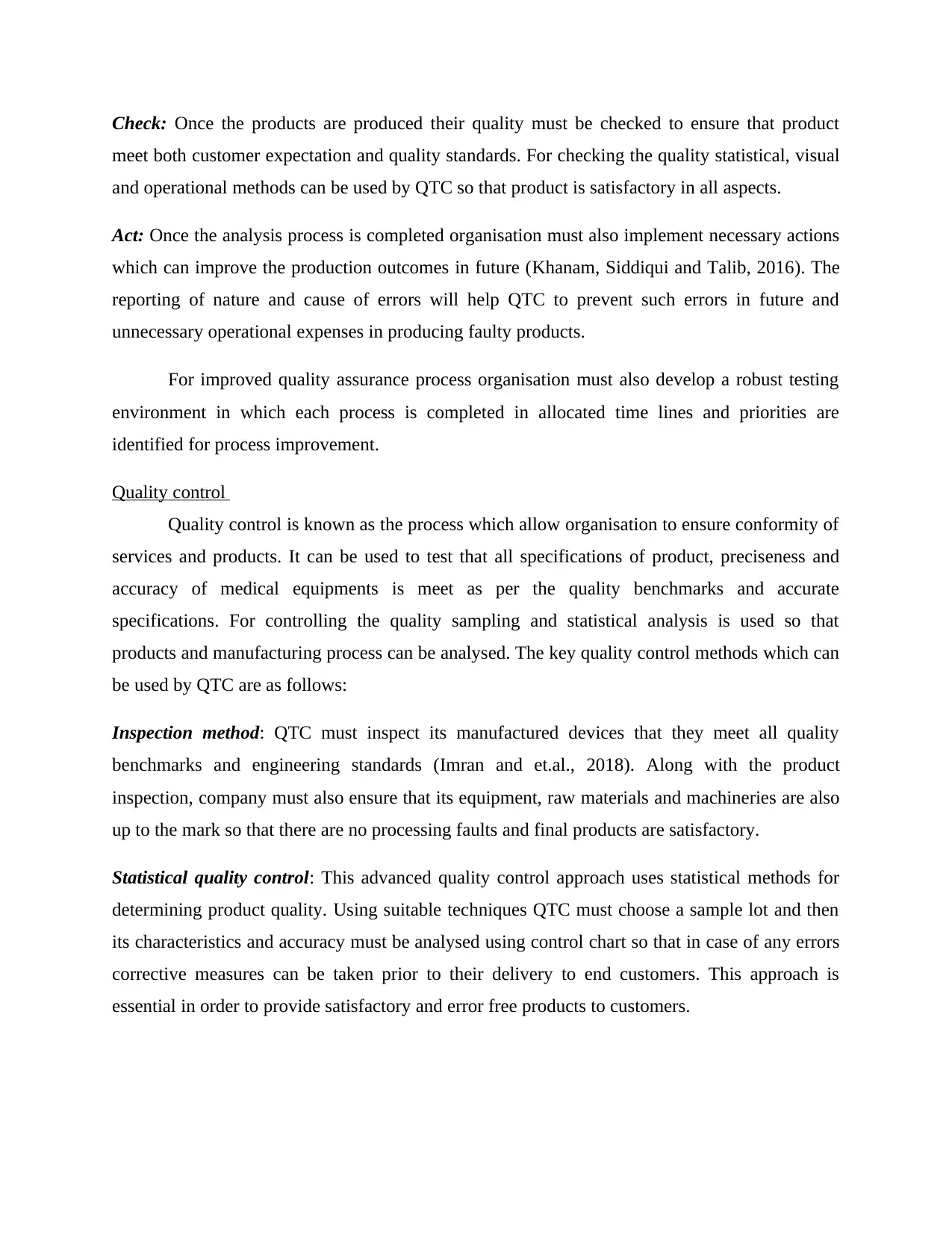
Check: Once the products are produced their quality must be checked to ensure that product
meet both customer expectation and quality standards. For checking the quality statistical, visual
and operational methods can be used by QTC so that product is satisfactory in all aspects.
Act: Once the analysis process is completed organisation must also implement necessary actions
which can improve the production outcomes in future (Khanam, Siddiqui and Talib, 2016). The
reporting of nature and cause of errors will help QTC to prevent such errors in future and
unnecessary operational expenses in producing faulty products.
For improved quality assurance process organisation must also develop a robust testing
environment in which each process is completed in allocated time lines and priorities are
identified for process improvement.
Quality control
Quality control is known as the process which allow organisation to ensure conformity of
services and products. It can be used to test that all specifications of product, preciseness and
accuracy of medical equipments is meet as per the quality benchmarks and accurate
specifications. For controlling the quality sampling and statistical analysis is used so that
products and manufacturing process can be analysed. The key quality control methods which can
be used by QTC are as follows:
Inspection method: QTC must inspect its manufactured devices that they meet all quality
benchmarks and engineering standards (Imran and et.al., 2018). Along with the product
inspection, company must also ensure that its equipment, raw materials and machineries are also
up to the mark so that there are no processing faults and final products are satisfactory.
Statistical quality control: This advanced quality control approach uses statistical methods for
determining product quality. Using suitable techniques QTC must choose a sample lot and then
its characteristics and accuracy must be analysed using control chart so that in case of any errors
corrective measures can be taken prior to their delivery to end customers. This approach is
essential in order to provide satisfactory and error free products to customers.
meet both customer expectation and quality standards. For checking the quality statistical, visual
and operational methods can be used by QTC so that product is satisfactory in all aspects.
Act: Once the analysis process is completed organisation must also implement necessary actions
which can improve the production outcomes in future (Khanam, Siddiqui and Talib, 2016). The
reporting of nature and cause of errors will help QTC to prevent such errors in future and
unnecessary operational expenses in producing faulty products.
For improved quality assurance process organisation must also develop a robust testing
environment in which each process is completed in allocated time lines and priorities are
identified for process improvement.
Quality control
Quality control is known as the process which allow organisation to ensure conformity of
services and products. It can be used to test that all specifications of product, preciseness and
accuracy of medical equipments is meet as per the quality benchmarks and accurate
specifications. For controlling the quality sampling and statistical analysis is used so that
products and manufacturing process can be analysed. The key quality control methods which can
be used by QTC are as follows:
Inspection method: QTC must inspect its manufactured devices that they meet all quality
benchmarks and engineering standards (Imran and et.al., 2018). Along with the product
inspection, company must also ensure that its equipment, raw materials and machineries are also
up to the mark so that there are no processing faults and final products are satisfactory.
Statistical quality control: This advanced quality control approach uses statistical methods for
determining product quality. Using suitable techniques QTC must choose a sample lot and then
its characteristics and accuracy must be analysed using control chart so that in case of any errors
corrective measures can be taken prior to their delivery to end customers. This approach is
essential in order to provide satisfactory and error free products to customers.
Paraphrase This Document
Need a fresh take? Get an instant paraphrase of this document with our AI Paraphraser
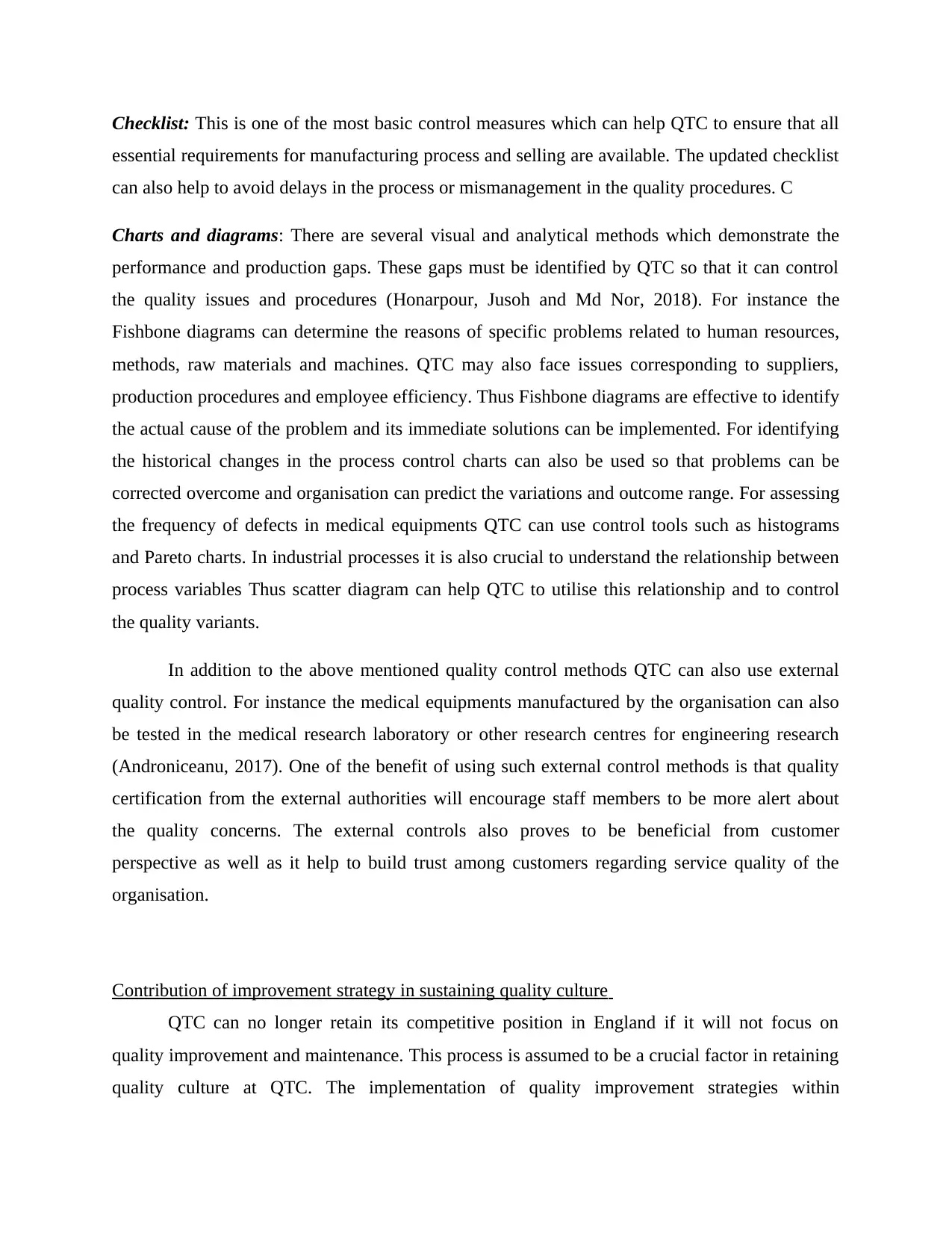
Checklist: This is one of the most basic control measures which can help QTC to ensure that all
essential requirements for manufacturing process and selling are available. The updated checklist
can also help to avoid delays in the process or mismanagement in the quality procedures. C
Charts and diagrams: There are several visual and analytical methods which demonstrate the
performance and production gaps. These gaps must be identified by QTC so that it can control
the quality issues and procedures (Honarpour, Jusoh and Md Nor, 2018). For instance the
Fishbone diagrams can determine the reasons of specific problems related to human resources,
methods, raw materials and machines. QTC may also face issues corresponding to suppliers,
production procedures and employee efficiency. Thus Fishbone diagrams are effective to identify
the actual cause of the problem and its immediate solutions can be implemented. For identifying
the historical changes in the process control charts can also be used so that problems can be
corrected overcome and organisation can predict the variations and outcome range. For assessing
the frequency of defects in medical equipments QTC can use control tools such as histograms
and Pareto charts. In industrial processes it is also crucial to understand the relationship between
process variables Thus scatter diagram can help QTC to utilise this relationship and to control
the quality variants.
In addition to the above mentioned quality control methods QTC can also use external
quality control. For instance the medical equipments manufactured by the organisation can also
be tested in the medical research laboratory or other research centres for engineering research
(Androniceanu, 2017). One of the benefit of using such external control methods is that quality
certification from the external authorities will encourage staff members to be more alert about
the quality concerns. The external controls also proves to be beneficial from customer
perspective as well as it help to build trust among customers regarding service quality of the
organisation.
Contribution of improvement strategy in sustaining quality culture
QTC can no longer retain its competitive position in England if it will not focus on
quality improvement and maintenance. This process is assumed to be a crucial factor in retaining
quality culture at QTC. The implementation of quality improvement strategies within
essential requirements for manufacturing process and selling are available. The updated checklist
can also help to avoid delays in the process or mismanagement in the quality procedures. C
Charts and diagrams: There are several visual and analytical methods which demonstrate the
performance and production gaps. These gaps must be identified by QTC so that it can control
the quality issues and procedures (Honarpour, Jusoh and Md Nor, 2018). For instance the
Fishbone diagrams can determine the reasons of specific problems related to human resources,
methods, raw materials and machines. QTC may also face issues corresponding to suppliers,
production procedures and employee efficiency. Thus Fishbone diagrams are effective to identify
the actual cause of the problem and its immediate solutions can be implemented. For identifying
the historical changes in the process control charts can also be used so that problems can be
corrected overcome and organisation can predict the variations and outcome range. For assessing
the frequency of defects in medical equipments QTC can use control tools such as histograms
and Pareto charts. In industrial processes it is also crucial to understand the relationship between
process variables Thus scatter diagram can help QTC to utilise this relationship and to control
the quality variants.
In addition to the above mentioned quality control methods QTC can also use external
quality control. For instance the medical equipments manufactured by the organisation can also
be tested in the medical research laboratory or other research centres for engineering research
(Androniceanu, 2017). One of the benefit of using such external control methods is that quality
certification from the external authorities will encourage staff members to be more alert about
the quality concerns. The external controls also proves to be beneficial from customer
perspective as well as it help to build trust among customers regarding service quality of the
organisation.
Contribution of improvement strategy in sustaining quality culture
QTC can no longer retain its competitive position in England if it will not focus on
quality improvement and maintenance. This process is assumed to be a crucial factor in retaining
quality culture at QTC. The implementation of quality improvement strategies within
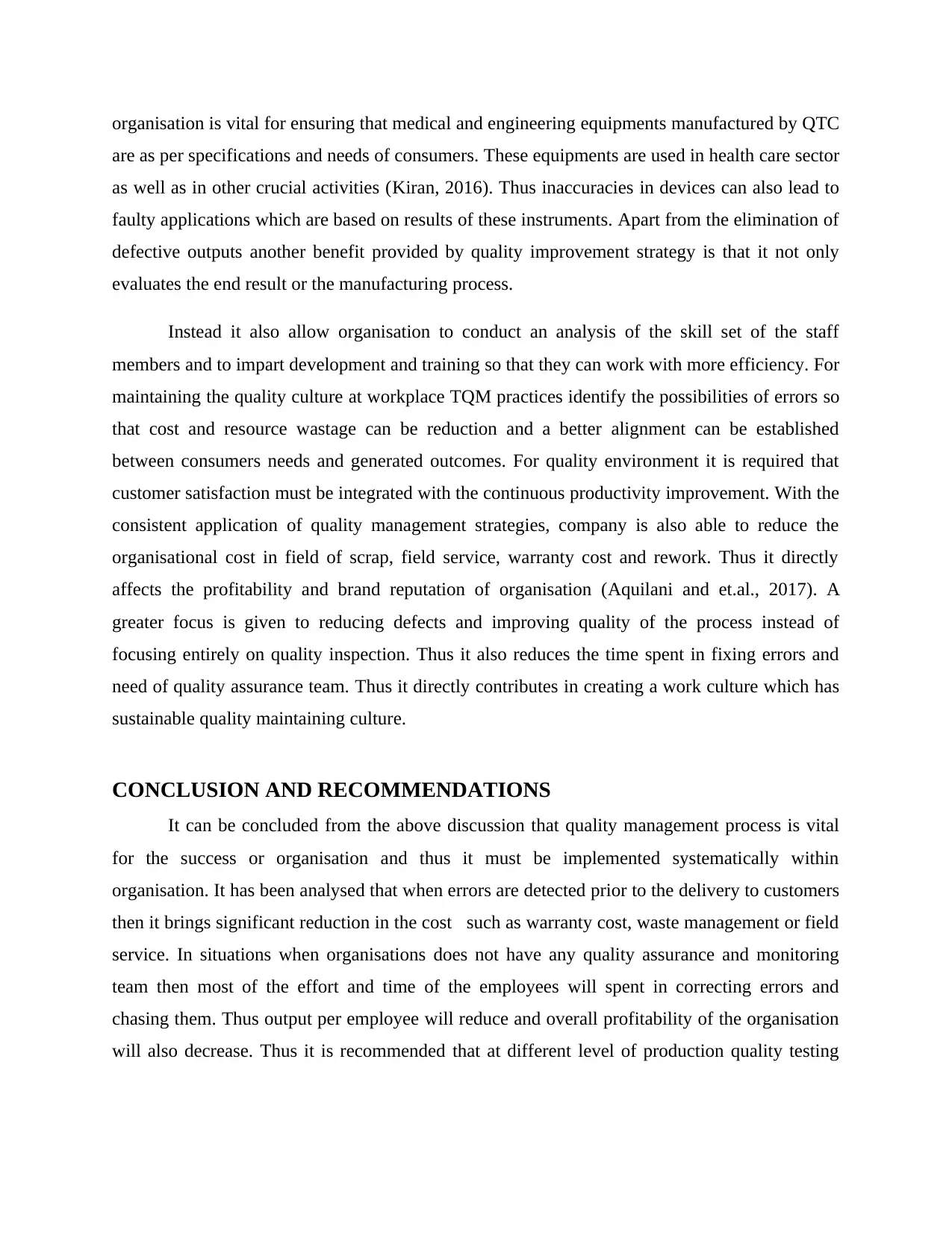
organisation is vital for ensuring that medical and engineering equipments manufactured by QTC
are as per specifications and needs of consumers. These equipments are used in health care sector
as well as in other crucial activities (Kiran, 2016). Thus inaccuracies in devices can also lead to
faulty applications which are based on results of these instruments. Apart from the elimination of
defective outputs another benefit provided by quality improvement strategy is that it not only
evaluates the end result or the manufacturing process.
Instead it also allow organisation to conduct an analysis of the skill set of the staff
members and to impart development and training so that they can work with more efficiency. For
maintaining the quality culture at workplace TQM practices identify the possibilities of errors so
that cost and resource wastage can be reduction and a better alignment can be established
between consumers needs and generated outcomes. For quality environment it is required that
customer satisfaction must be integrated with the continuous productivity improvement. With the
consistent application of quality management strategies, company is also able to reduce the
organisational cost in field of scrap, field service, warranty cost and rework. Thus it directly
affects the profitability and brand reputation of organisation (Aquilani and et.al., 2017). A
greater focus is given to reducing defects and improving quality of the process instead of
focusing entirely on quality inspection. Thus it also reduces the time spent in fixing errors and
need of quality assurance team. Thus it directly contributes in creating a work culture which has
sustainable quality maintaining culture.
CONCLUSION AND RECOMMENDATIONS
It can be concluded from the above discussion that quality management process is vital
for the success or organisation and thus it must be implemented systematically within
organisation. It has been analysed that when errors are detected prior to the delivery to customers
then it brings significant reduction in the cost such as warranty cost, waste management or field
service. In situations when organisations does not have any quality assurance and monitoring
team then most of the effort and time of the employees will spent in correcting errors and
chasing them. Thus output per employee will reduce and overall profitability of the organisation
will also decrease. Thus it is recommended that at different level of production quality testing
are as per specifications and needs of consumers. These equipments are used in health care sector
as well as in other crucial activities (Kiran, 2016). Thus inaccuracies in devices can also lead to
faulty applications which are based on results of these instruments. Apart from the elimination of
defective outputs another benefit provided by quality improvement strategy is that it not only
evaluates the end result or the manufacturing process.
Instead it also allow organisation to conduct an analysis of the skill set of the staff
members and to impart development and training so that they can work with more efficiency. For
maintaining the quality culture at workplace TQM practices identify the possibilities of errors so
that cost and resource wastage can be reduction and a better alignment can be established
between consumers needs and generated outcomes. For quality environment it is required that
customer satisfaction must be integrated with the continuous productivity improvement. With the
consistent application of quality management strategies, company is also able to reduce the
organisational cost in field of scrap, field service, warranty cost and rework. Thus it directly
affects the profitability and brand reputation of organisation (Aquilani and et.al., 2017). A
greater focus is given to reducing defects and improving quality of the process instead of
focusing entirely on quality inspection. Thus it also reduces the time spent in fixing errors and
need of quality assurance team. Thus it directly contributes in creating a work culture which has
sustainable quality maintaining culture.
CONCLUSION AND RECOMMENDATIONS
It can be concluded from the above discussion that quality management process is vital
for the success or organisation and thus it must be implemented systematically within
organisation. It has been analysed that when errors are detected prior to the delivery to customers
then it brings significant reduction in the cost such as warranty cost, waste management or field
service. In situations when organisations does not have any quality assurance and monitoring
team then most of the effort and time of the employees will spent in correcting errors and
chasing them. Thus output per employee will reduce and overall profitability of the organisation
will also decrease. Thus it is recommended that at different level of production quality testing
⊘ This is a preview!⊘
Do you want full access?
Subscribe today to unlock all pages.

Trusted by 1+ million students worldwide
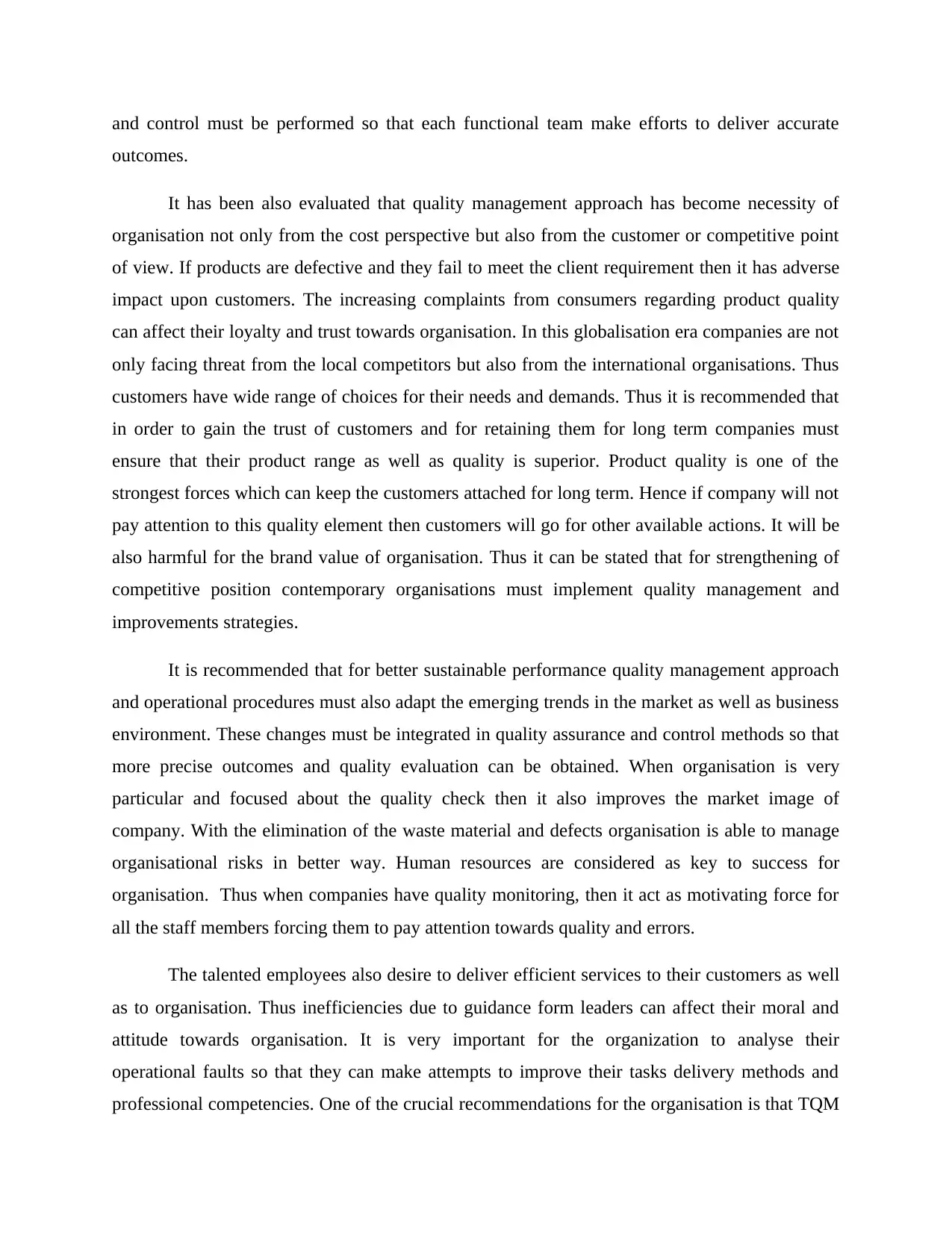
and control must be performed so that each functional team make efforts to deliver accurate
outcomes.
It has been also evaluated that quality management approach has become necessity of
organisation not only from the cost perspective but also from the customer or competitive point
of view. If products are defective and they fail to meet the client requirement then it has adverse
impact upon customers. The increasing complaints from consumers regarding product quality
can affect their loyalty and trust towards organisation. In this globalisation era companies are not
only facing threat from the local competitors but also from the international organisations. Thus
customers have wide range of choices for their needs and demands. Thus it is recommended that
in order to gain the trust of customers and for retaining them for long term companies must
ensure that their product range as well as quality is superior. Product quality is one of the
strongest forces which can keep the customers attached for long term. Hence if company will not
pay attention to this quality element then customers will go for other available actions. It will be
also harmful for the brand value of organisation. Thus it can be stated that for strengthening of
competitive position contemporary organisations must implement quality management and
improvements strategies.
It is recommended that for better sustainable performance quality management approach
and operational procedures must also adapt the emerging trends in the market as well as business
environment. These changes must be integrated in quality assurance and control methods so that
more precise outcomes and quality evaluation can be obtained. When organisation is very
particular and focused about the quality check then it also improves the market image of
company. With the elimination of the waste material and defects organisation is able to manage
organisational risks in better way. Human resources are considered as key to success for
organisation. Thus when companies have quality monitoring, then it act as motivating force for
all the staff members forcing them to pay attention towards quality and errors.
The talented employees also desire to deliver efficient services to their customers as well
as to organisation. Thus inefficiencies due to guidance form leaders can affect their moral and
attitude towards organisation. It is very important for the organization to analyse their
operational faults so that they can make attempts to improve their tasks delivery methods and
professional competencies. One of the crucial recommendations for the organisation is that TQM
outcomes.
It has been also evaluated that quality management approach has become necessity of
organisation not only from the cost perspective but also from the customer or competitive point
of view. If products are defective and they fail to meet the client requirement then it has adverse
impact upon customers. The increasing complaints from consumers regarding product quality
can affect their loyalty and trust towards organisation. In this globalisation era companies are not
only facing threat from the local competitors but also from the international organisations. Thus
customers have wide range of choices for their needs and demands. Thus it is recommended that
in order to gain the trust of customers and for retaining them for long term companies must
ensure that their product range as well as quality is superior. Product quality is one of the
strongest forces which can keep the customers attached for long term. Hence if company will not
pay attention to this quality element then customers will go for other available actions. It will be
also harmful for the brand value of organisation. Thus it can be stated that for strengthening of
competitive position contemporary organisations must implement quality management and
improvements strategies.
It is recommended that for better sustainable performance quality management approach
and operational procedures must also adapt the emerging trends in the market as well as business
environment. These changes must be integrated in quality assurance and control methods so that
more precise outcomes and quality evaluation can be obtained. When organisation is very
particular and focused about the quality check then it also improves the market image of
company. With the elimination of the waste material and defects organisation is able to manage
organisational risks in better way. Human resources are considered as key to success for
organisation. Thus when companies have quality monitoring, then it act as motivating force for
all the staff members forcing them to pay attention towards quality and errors.
The talented employees also desire to deliver efficient services to their customers as well
as to organisation. Thus inefficiencies due to guidance form leaders can affect their moral and
attitude towards organisation. It is very important for the organization to analyse their
operational faults so that they can make attempts to improve their tasks delivery methods and
professional competencies. One of the crucial recommendations for the organisation is that TQM
Paraphrase This Document
Need a fresh take? Get an instant paraphrase of this document with our AI Paraphraser
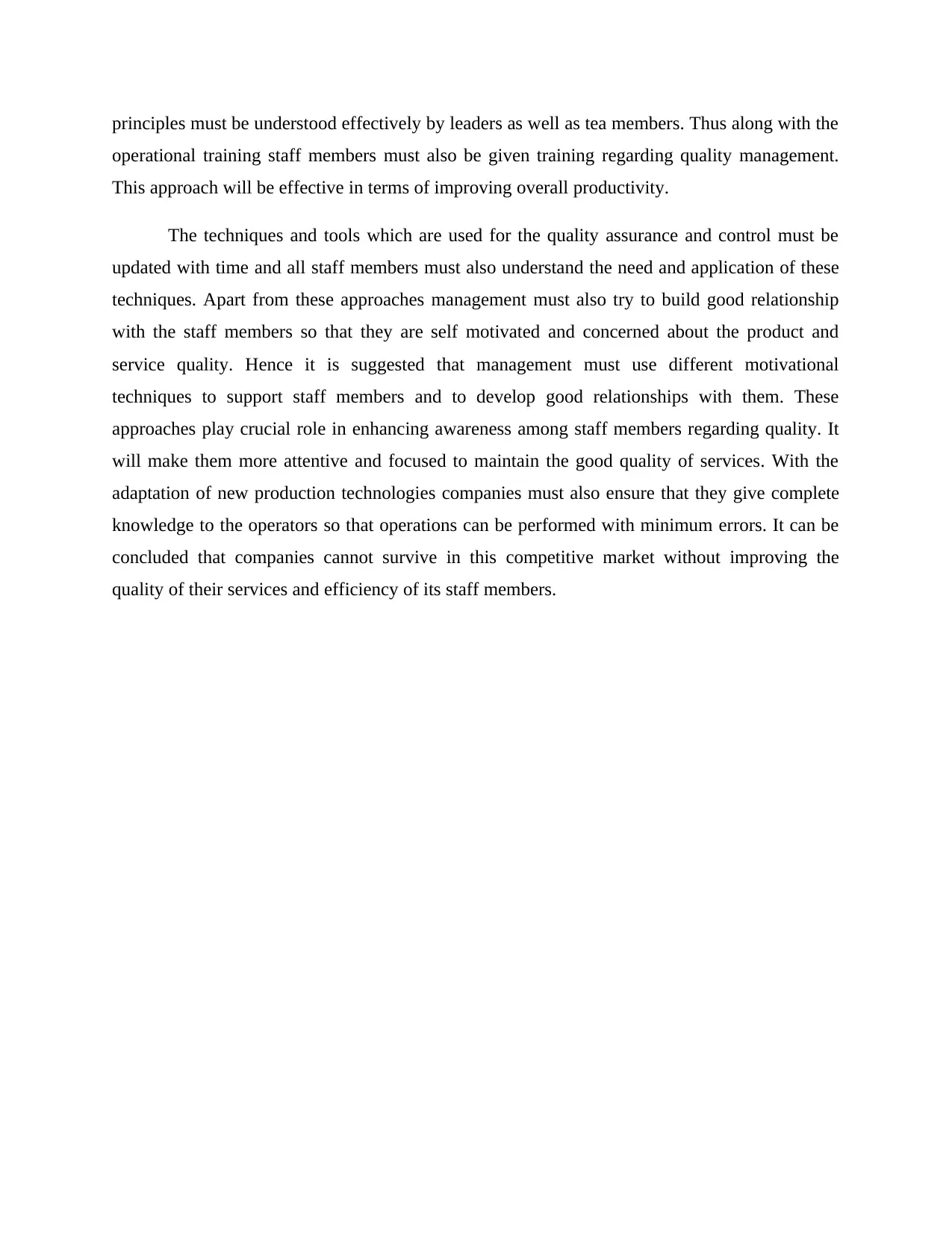
principles must be understood effectively by leaders as well as tea members. Thus along with the
operational training staff members must also be given training regarding quality management.
This approach will be effective in terms of improving overall productivity.
The techniques and tools which are used for the quality assurance and control must be
updated with time and all staff members must also understand the need and application of these
techniques. Apart from these approaches management must also try to build good relationship
with the staff members so that they are self motivated and concerned about the product and
service quality. Hence it is suggested that management must use different motivational
techniques to support staff members and to develop good relationships with them. These
approaches play crucial role in enhancing awareness among staff members regarding quality. It
will make them more attentive and focused to maintain the good quality of services. With the
adaptation of new production technologies companies must also ensure that they give complete
knowledge to the operators so that operations can be performed with minimum errors. It can be
concluded that companies cannot survive in this competitive market without improving the
quality of their services and efficiency of its staff members.
operational training staff members must also be given training regarding quality management.
This approach will be effective in terms of improving overall productivity.
The techniques and tools which are used for the quality assurance and control must be
updated with time and all staff members must also understand the need and application of these
techniques. Apart from these approaches management must also try to build good relationship
with the staff members so that they are self motivated and concerned about the product and
service quality. Hence it is suggested that management must use different motivational
techniques to support staff members and to develop good relationships with them. These
approaches play crucial role in enhancing awareness among staff members regarding quality. It
will make them more attentive and focused to maintain the good quality of services. With the
adaptation of new production technologies companies must also ensure that they give complete
knowledge to the operators so that operations can be performed with minimum errors. It can be
concluded that companies cannot survive in this competitive market without improving the
quality of their services and efficiency of its staff members.
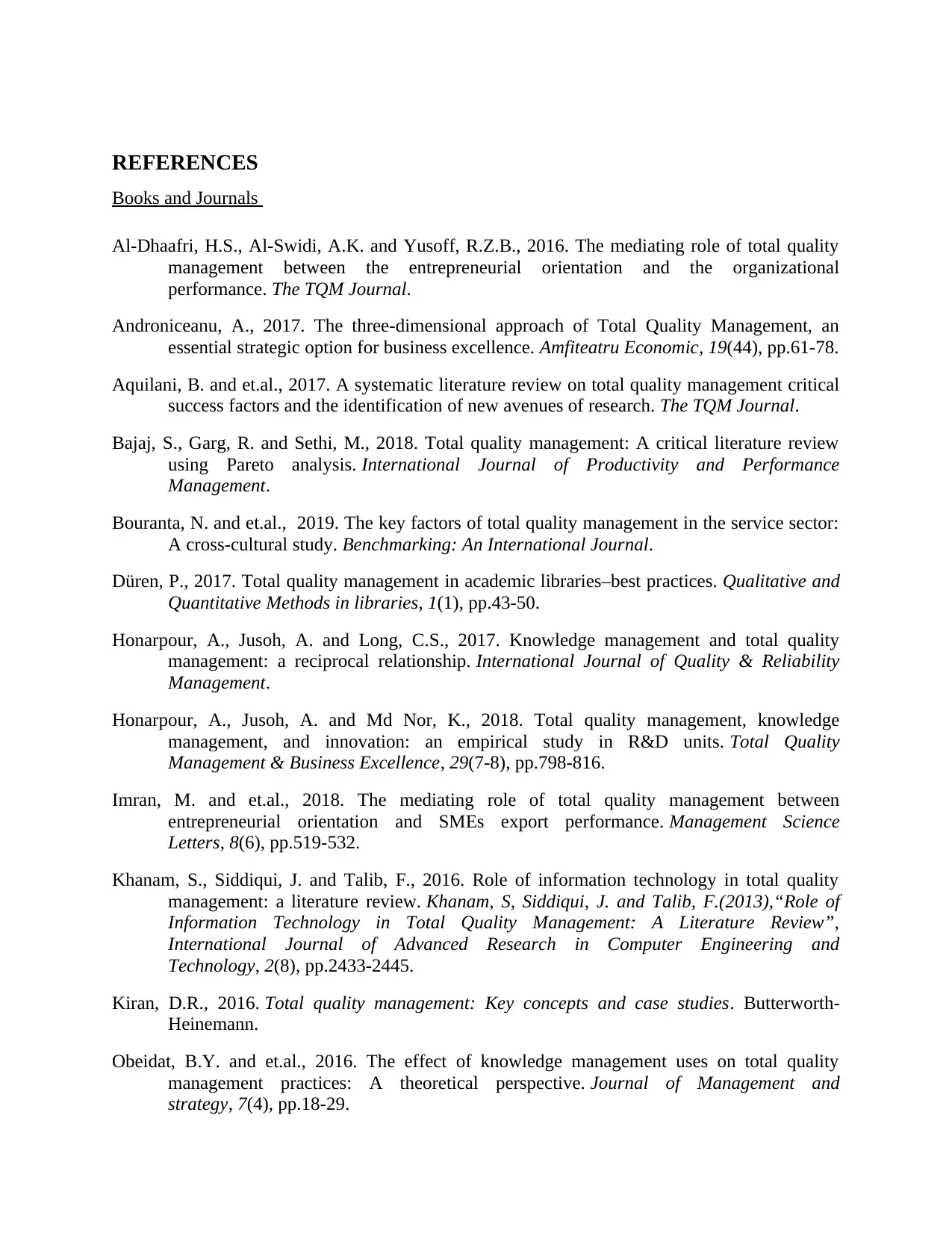
REFERENCES
Books and Journals
Al-Dhaafri, H.S., Al-Swidi, A.K. and Yusoff, R.Z.B., 2016. The mediating role of total quality
management between the entrepreneurial orientation and the organizational
performance. The TQM Journal.
Androniceanu, A., 2017. The three-dimensional approach of Total Quality Management, an
essential strategic option for business excellence. Amfiteatru Economic, 19(44), pp.61-78.
Aquilani, B. and et.al., 2017. A systematic literature review on total quality management critical
success factors and the identification of new avenues of research. The TQM Journal.
Bajaj, S., Garg, R. and Sethi, M., 2018. Total quality management: A critical literature review
using Pareto analysis. International Journal of Productivity and Performance
Management.
Bouranta, N. and et.al., 2019. The key factors of total quality management in the service sector:
A cross-cultural study. Benchmarking: An International Journal.
Düren, P., 2017. Total quality management in academic libraries–best practices. Qualitative and
Quantitative Methods in libraries, 1(1), pp.43-50.
Honarpour, A., Jusoh, A. and Long, C.S., 2017. Knowledge management and total quality
management: a reciprocal relationship. International Journal of Quality & Reliability
Management.
Honarpour, A., Jusoh, A. and Md Nor, K., 2018. Total quality management, knowledge
management, and innovation: an empirical study in R&D units. Total Quality
Management & Business Excellence, 29(7-8), pp.798-816.
Imran, M. and et.al., 2018. The mediating role of total quality management between
entrepreneurial orientation and SMEs export performance. Management Science
Letters, 8(6), pp.519-532.
Khanam, S., Siddiqui, J. and Talib, F., 2016. Role of information technology in total quality
management: a literature review. Khanam, S, Siddiqui, J. and Talib, F.(2013),“Role of
Information Technology in Total Quality Management: A Literature Review”,
International Journal of Advanced Research in Computer Engineering and
Technology, 2(8), pp.2433-2445.
Kiran, D.R., 2016. Total quality management: Key concepts and case studies. Butterworth-
Heinemann.
Obeidat, B.Y. and et.al., 2016. The effect of knowledge management uses on total quality
management practices: A theoretical perspective. Journal of Management and
strategy, 7(4), pp.18-29.
Books and Journals
Al-Dhaafri, H.S., Al-Swidi, A.K. and Yusoff, R.Z.B., 2016. The mediating role of total quality
management between the entrepreneurial orientation and the organizational
performance. The TQM Journal.
Androniceanu, A., 2017. The three-dimensional approach of Total Quality Management, an
essential strategic option for business excellence. Amfiteatru Economic, 19(44), pp.61-78.
Aquilani, B. and et.al., 2017. A systematic literature review on total quality management critical
success factors and the identification of new avenues of research. The TQM Journal.
Bajaj, S., Garg, R. and Sethi, M., 2018. Total quality management: A critical literature review
using Pareto analysis. International Journal of Productivity and Performance
Management.
Bouranta, N. and et.al., 2019. The key factors of total quality management in the service sector:
A cross-cultural study. Benchmarking: An International Journal.
Düren, P., 2017. Total quality management in academic libraries–best practices. Qualitative and
Quantitative Methods in libraries, 1(1), pp.43-50.
Honarpour, A., Jusoh, A. and Long, C.S., 2017. Knowledge management and total quality
management: a reciprocal relationship. International Journal of Quality & Reliability
Management.
Honarpour, A., Jusoh, A. and Md Nor, K., 2018. Total quality management, knowledge
management, and innovation: an empirical study in R&D units. Total Quality
Management & Business Excellence, 29(7-8), pp.798-816.
Imran, M. and et.al., 2018. The mediating role of total quality management between
entrepreneurial orientation and SMEs export performance. Management Science
Letters, 8(6), pp.519-532.
Khanam, S., Siddiqui, J. and Talib, F., 2016. Role of information technology in total quality
management: a literature review. Khanam, S, Siddiqui, J. and Talib, F.(2013),“Role of
Information Technology in Total Quality Management: A Literature Review”,
International Journal of Advanced Research in Computer Engineering and
Technology, 2(8), pp.2433-2445.
Kiran, D.R., 2016. Total quality management: Key concepts and case studies. Butterworth-
Heinemann.
Obeidat, B.Y. and et.al., 2016. The effect of knowledge management uses on total quality
management practices: A theoretical perspective. Journal of Management and
strategy, 7(4), pp.18-29.
⊘ This is a preview!⊘
Do you want full access?
Subscribe today to unlock all pages.

Trusted by 1+ million students worldwide
1 out of 13
Related Documents
Your All-in-One AI-Powered Toolkit for Academic Success.
+13062052269
info@desklib.com
Available 24*7 on WhatsApp / Email
![[object Object]](/_next/static/media/star-bottom.7253800d.svg)
Unlock your academic potential
Copyright © 2020–2025 A2Z Services. All Rights Reserved. Developed and managed by ZUCOL.




